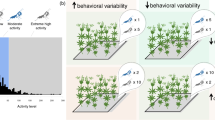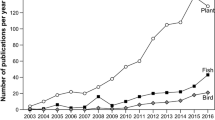Summary
Periodicity, predictability and stochasticity of environmental perturbations are shown to influence the community structure that develops in microcosms. Sets of replicate, microalgal communities were subjected to different temporal patterns of rarefaction and resource resupply and their species-abundance patterns after 120 days of such manipulations were determined. Perturbations having, 1, 7, and 28 day periodicities differentially effected community structure. The predictability of these perturbations had a less profound influence on the communities which developed than the average perturbation periodicity.
Similar content being viewed by others
References
Andrewartha HG, Birch LC (1954) The Distribution and Abundance of Animals. Univ Chicago Press, Chicago, p 782
Connell JH (1975) Some mechanisms producting structure in natural communities: A model and evidence from field experiments. In: Cody ML, Diamond JM (eds) Ecology and Evolution of Communities. Belknap Press, Cambridge Mass, pp 460–490
Connell JH (1978) Diversity in tropical rain forests and coral reefs. Science 199:1302–1310
Connell JH, Orias E (1964) The ecological regulation of species diversity. Amer Natur 98:399–414
Dayton PK (1971) Competition, disturbance and community organization: The provision and subsequent utilization of space in a rocky intertidal community. Ecol Monogr 41:351–389
Dixon WJ, Brown MB (eds) (1979) BMDP-79, Biomedical Computer Programs P-Series. University of California Press. Berkley, Ca.
Feldman MW, Roughgarden J (1975) A population's stationary distribution and chance of extinction in a stochastic environment with remarks on the theory of species packing. Theor Pop Biol 7:197–207
Greeney WJ, Bella DA, Curl HC (1973) A theoretical approach to interspecific competition in the phytoplankton community. Amer Natur 107:405–423
Huffaker CB (1958) Experimental studies on predation: Dispersion factors and predatory-prey oscillations. Hilgardia 27:343–383
Hutchinson GE (1961) The paradox of the plankton. Amer Natur 95:137–146
Ladde GS, Siljak DD (1975) Stability of multispecies communities in a randomly varying environment. J Math Biol 2:165–178
Lehman JT (1976) Photosynthetic capacity and luxury uptake of carbon during phosphate limitation in Pediastrum duplex (Chlorophyceae). J Phyc 12:190–193
Lehman JT, Scavia D (1982) Microscale patchiness of nutrients in plankton communities. Science 216:729–730
Leigh EG (1975) Population fluctuations, community stability and environmental variability. Cody ML, Diamond DM (eds) Ecology and Evolution of Communities. Belknap Press, Cambridge, Massachusetts, pp 51–73
Levins R (1968) Evolution in changing environments: some theoretical explorations. Princeton University Press, Princeton, p 120
Levins R (1969) The effect of random variations of different types on population growth. PNAS 62:1061–1065
Levins R (1979) Coexistence in a variable environment. Amer Natur 114:765–783
Lewontin RC, Cohen D (1969) On population growth in a randomly varying environment. PNAS 62:1056–1060
MacArthur JW (1975) Environmental fluctuations and species diversity. In: Cody ML, Diamond JM (eds) Ecology and Evolution of Communities. Belknap Press, Cambridge, Massachusetts, pp 74–80
May RM (1973a) Stability and Complexity in Model Ecosystems. Princeton Univ Press, Princeton, N, p 235
May RM (1973a) Stability in randomly fluctuating versus deterministic environments. Amer Natur 107:621–650
May RM, MacArthur RH (1972) Niche overlap as a function of environmental variability. Proc Nat Acad Sci 69:1109–1113
Morrison DF (1976) Multivariate Statistical Methods. Second Edition. McGraw-Hill, New York
Nie NH, Hull CH, Jenkins JG, Steinbrenner K, Bent DH (1975) Statistical Package for the Social Sciences, second edition. McGraw-Hill, New York
Patrick R (1963) The structure of diatom communities under varying ecological conditions. In: Conference on the Problems of Environmental Control of the Morphology of Fossil and Recent Protobionta. Trans NY Acad Sci 108:359–365
Rickerson P, Armstrong K, Goldman CR (1970) Contemporaneous disequilibrium: A new hypothesis to explain the paradox of the plankton. Proc Nat Acad Sci USA 67:1710–1714
Robinson JV, Valentine WD (1979) The concepts of elasticity, invulnerability, and invadability. J theor Biol 81:91–104
Robinson JV (1981) An assortative model of island biogeography. J Social Biol Struct 4:7–18
Roughgarden J (1979) Theory of Population Genetics and Evolutionary Ecology: An Introduction. MacMillan, New York, p 634
Sournia A (ed) (1978) Phytoplankton Manual. UNESCO publ. no. 6. Paris, p 337
Slatkin M, Lande R (1976) Niche width in a fluctuating environment — density independent model. Amer Natur 110:31–55
Slobodkin LB, Sanders HL (1969) On the contribution of environmental predictability to species diversity. Brookhaven Symp Biol 22:82–93
Tilman D (1977) Resource competition between planktonic algae: an experimental and theoretical approach. Ecology 58:338–348
Turpin DH, Harrison PJ (1979) Limiting nutrient patchiness and its role in phytoplankton ecology. J exp mar Biol Ecol 39:151–166
Turpin DH, Parslow JS, Harrison PJ (1981) On limiting nutrient patchiness and phytoplankton growth: A conceptual approach. J Plankton Research 3:421–431
Whittaker RH, Goodman D (1979) Classifying species according to their demographic strategy. 1. Population fluctuations and environmental heterogeneity. Amer Natur 113:185–200
Author information
Authors and Affiliations
Rights and permissions
About this article
Cite this article
Robinson, J.V., Sandgren, C.D. The effect of temporal environmental heterogeneity on community structure: a replicated experimental study. Oecologia 57, 98–102 (1983). https://doi.org/10.1007/BF00379566
Received:
Issue Date:
DOI: https://doi.org/10.1007/BF00379566




